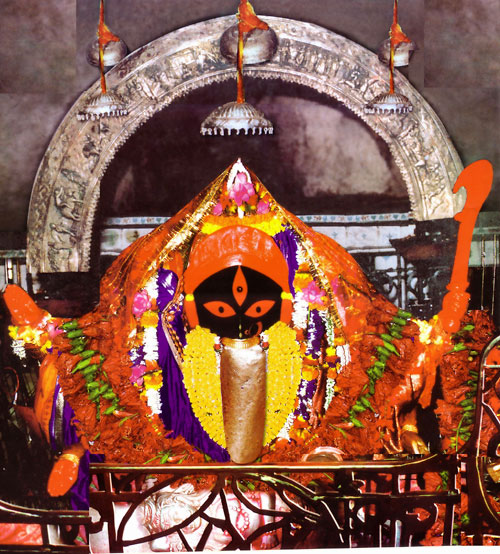Navratri
A lot of non-Hindus often wonder as to what is the festival of "Navratri" ?
There are two Navratris - one in the summer - Chaitra-Navratri and one in the Autumn - Asho Navratri.
Navratri are nine nights when we worship and offer our thanks the female principle of nature and the goddesses connected to them. As the agricultural communities had free time only in the evenings - days being too busy with manual labour in the fields, evenings and nights were chosen as the ideal times to celebrate the festival of the goddesses. Having harvested the crops, historically, farmers in India used to pay their "tax" after the spring and monsoon harvest - ie just after Navratri.In brief, the nine nights are dedicated to the three main goddesses of Hinduism - Kali, Lakshmi and Sarasvati. India being so diverse, different sects and communities worship different aspects of these goddess in different ways.
Three nights are dedicated to the goddess of action and energy. Her different manifestations viz Kumari, Parvati and Kali are worshipped during these days. They represent the three natures/ classes of womanhood - the virgin young girl, auspicious wife/ mother and the angry old hag ! This is not a criticism of women, just a classification. It helps us recognise the different aspects of our own nature.
Lakshmi is worshipped for three days in her various aspects as the goddesses of peace, plenty and bliss. Fulfilment is more important than wealth itself. As the goddess of wealth, she governs not just the bank balance, but also such essential things as family, friends, food etc. (read my article on wealth on my site.)
Saraswati is the goddess of knowledge. Not just the knowledge of how to earn a living, but how to "live" aswell. She is the goddess of the spiritual knowledge and the knowledge that frees us from this bind of Samsara.
The nine nights are there for us to revel in the knowledge of the goddesses that live within us, imbibing us with their spiritual energy and power. Used for the good, they help liberate us from the mire of this world. Use these energies unwisely, and they will snare us in the maya of this world. We should meditate of these aspects of the nine nights, that was the reason they originally came into being.
Navratri celebrates the victory of Rama over Ravan - hence we burn the effegy of Ravan on the tenth day - deshera. Just as Rakshabandhan is the new-year of the brahmins, Diwali is the new-year of the vaishya, holi is the newyear of the sudras, Navratri is the new-year of the kshatriyas. They worship various weapons on Deshera and vow to fight for justice in society. To this day, the royals of India (though divested of their kingdoms), still celebrate the festival in style. Mysore is particularly well known for its pomp and ceremony during Navratri, culminating in a magnificent puja on the tenth day.
In South India, they worshsip the goddess and make special displays of dolls to commemorate the festival.
At the 52 Shakti-peethas, the Goddess is offered special pujas during the Navratri.
At Tirupati, the autumn Navratri is celebrated as Brahma-Mahotsav and the Uttsav Svarups of the Lord Tirupati go on special "yatras" around the town.
Bengalis celebrate the festival by worshiping giant statues of the goddesses with a great deal of pomp and ceremony. Images are made from clay and straw. These images are immersed in the rivers to dissipate the divine energy back to nature.
Gujaratis celebrate by dancing around a lamp placed in a pot with nine holes, where the lamp represent the soul and pot the body with its nine holes. The dance is called "garba" and it comprises of various combination of clapping and turning with grace and vigour. Raas is also played by dancing in pairs with stout (bamboo) sticks.
Ofcourse, much has been "added on" since and the nine nights are now as commercial as any other festival. The Gujaratis enjoy the nine nights by dancing them away to the blare of loud music and scant attention is given to the spiritual aspect of the festival.
Even the Durga Puja of the Bengalis has been hijacked by commercialism. Expensive "displays of the Pandals", mass distribution of prasad and inviting the right celeb to your function has taken over the sincere worship of the mother goddesses.
It is not enough to worship the goddess just during Navratri. We have to respect women and challenge violence against women at every stage - from killing female fetuses, denying them education, unwarranted whistling and comments as they walk past, so called 'eve teasing', harassment, domestic violence, unequal pay - and rape. Unless and until we respect women around us as goddess, what is the point of worshiping an idol as a goddess?
Make your worship of Mataji ALIVE by respecting women.
If you want more info on Kali, Lakshmi or Sarasvati and their various aspects, please read the articles on my site - or indeed follow the links to other sites that have info on Hindu gods.
Kali of Kolkotta
© Bhagwat [email protected]

